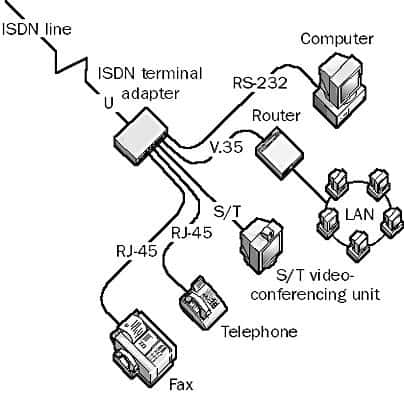Definition of ISDN Terminal Adapter in Network Encyclopedia.
What is ISDN Terminal Adapter?
ISDN Terminal Adapter is a device used at the customer premises to terminate a dial-up Integrated Services Digital Network (ISDN) line and connect it to a computer or a local area network (LAN).
You use a terminal adapter when you do not have dedicated ISDN telephone or computing equipment. Terminal adapters are sometimes called ISDN modems.
How it works
A terminal adapter connects using an RJ-45 connector to the U interface of the ISDN line at the customer premises and provides electrical termination for this line.
The other interface on the terminal adapter is typically an RS-232, RS-366, RS-530, or V.35 serial interface such as DB25, or a 34-pin connector for connecting the terminal adapter to a bridge, router, or computer at the customer premises.
Terminal adapters can include several RJ-11 connectors for connecting an analog telephone or a fax machine so that you can transfer data, talk on the telephone, and fax documents simultaneously over one ISDN line.
Some newer terminal adapters have an S/T interface for connecting to an S/T videoconferencing unit.

ISDN terminal adapters can be stand-alone AC powered devices or interface cards that you install on your computer. They can provide 128-Kbps throughput using the Bandwidth On Demand Interoperability Group (bonding) protocol for high-speed Internet and wide area network (WAN) connectivity, with higher effective data transfer rates using built-in data compression. Terminal adapters do not provide an “always on” network connection, but their latency time interval for establishing an ISDN connection is typically small (1 to 3 seconds). You can usually also configure an idle timer for dropping idle connections to save costs.
ISDN with inverse multiplexers
If you need more speed than ISDN but can’t afford to upgrade to T1 lines, try using an inverse multiplexer to combine several ISDN lines into one high-speed data pipe.
When you buy ISDN terminal adapters, be sure that they support the ISDN standard used by your telco. Such standards can include the National ISDN-1, ISDN-2, and ISDN-3 standards for AT&T, Northern Telecom, and Siemens. An ISDN terminal adapter with automatic service profile identifier (SPID) detection generally works with most ISDN installations.